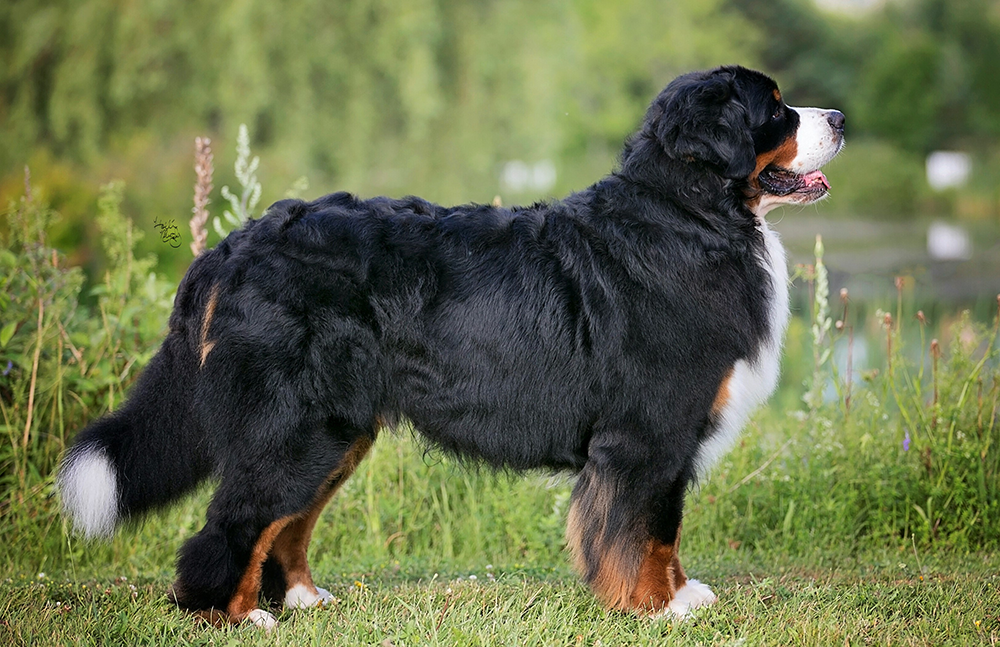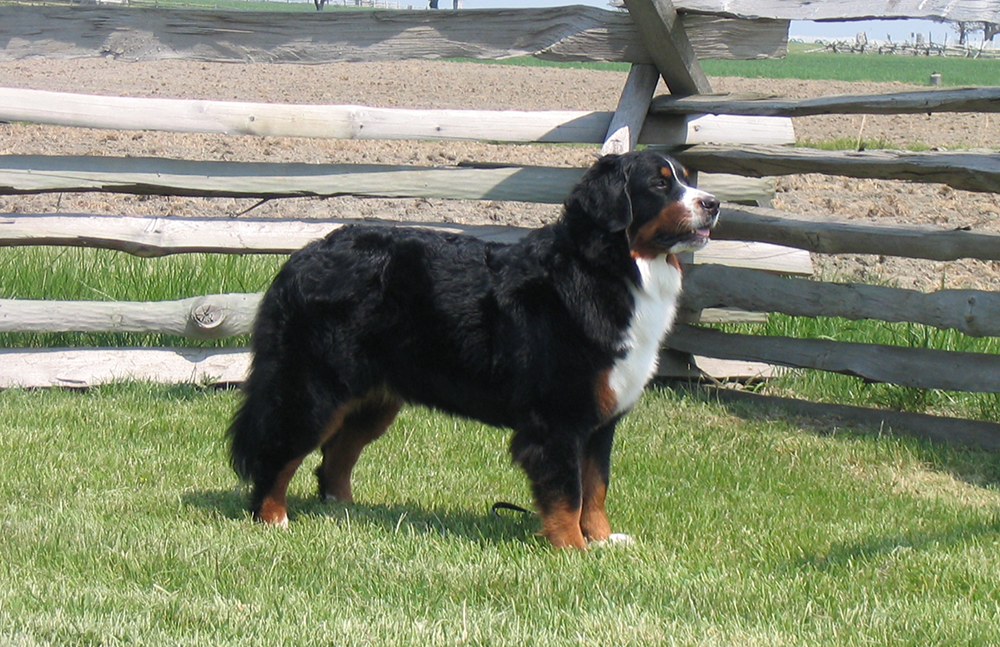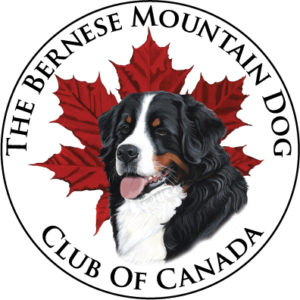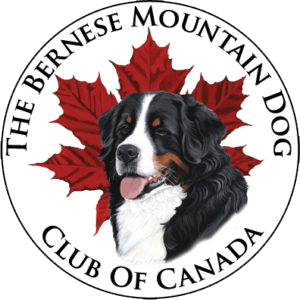
DOWNLOAD THE CANADIAN KENNEL CLUB OFFICIAL BREED STANDARD FOR THE BERNESE MOUNTAIN DOG
 |  |
ORIGIN AND PURPOSE
The Bernese Mountain Dog takes its name from the Canton of Bern in Switzerland, its native land. It is one of the four Swiss tri-colour breeds known by the collective name Sennenhunde, the only one of the four with a long coat. The Bernese Mountain Dog and its ancestors lived for many generations as all-purpose farm dogs, that protected homes/farms, and performed droving/herding and drafting tasks as required. From this background developed a hardy, natural, good-natured working breed that today is known principally as a faithful family companion.
GENERAL APPEARANCE
Large, strong, well-balanced working dog with sturdy built limbs. Heavy-coated with distinctive characteristic markings. Breed type encompasses more than markings, and focuses on structure, movement and temperament.
In comparison, males are larger than females with heavier bone, a broader skull, and greater depth and breadth of chest. Females, although more feminine, must maintain the sturdy breed type.
TEMPERAMENT
The Bernese temperament is one of the breed’s strongest assets. Self-confident, attentive, vigilant, fearless in every-day situations; good-natured, never sharp or shy, devoted to its own people, self-assured and placid towards strangers; of medium temperament.
SIZE
Dogs, 25-27.6 inches (64-70 cm), ideal size 26-26.8 inches (66-68 cm); Bitches 22.8-26 inches (58-66 cm), ideal size 23.6-24.8 inches (60-63 cm). Height measured at withers. The stocky, well-balanced appearance must be maintained.
COAT AND COLOUR
The adult coat is thick, moderately long. It has a bright natural shine, is straight or slightly wavy. In texture it is soft rather than harsh, is weather resistant, easily kept and resists matting. There is a soft, seasonal undercoat. Preferred marking: white feet with white reaching no higher than the pasterns without running up the back of the legs; white tip of tail; the white muzzle band preferably does not extend past the corners of the mouth.
HEAD
Strong in size, balanced to general appearance, not too massive. Skull: flat and broad with a slight furrow; defined, but not exaggerated stop. Muzzle: strong and straight; roughly square proportions, tapering only very slightly. Muzzle is slightly shorter than length of skull. Lips are tight fitting; black in colour. Teeth: jaw is strong with good teeth meeting in a scissor bite. Level bite acceptable. Dentition should be complete. Nostrils: well open and black in colour. Eyes: dark brown in colour, almond shaped, neither deep set or prominent and well set apart; tight eyelids. Expression is intelligent, animated and gentle. Ears: middle-sized, triangular in shape with rounded tip. Set above eye level high on side of head; hanging close to the head in repose, brought forward at the base when alert.
NECK
Strong, muscular of medium length, well set on. Dewlaps are very slightly developed.
BODY
Sturdy, slightly longer than tall. Chest: broad, forechest distinctly developed, with good depth of brisket reaching at least to the elbows; ribs are well sprung extending as far back as possible. Back: firm and level. Loins: broad, strong and muscular. Croup: broad, well muscled. Underline/belly: slightly rising from chest to hindquarters.
FOREQUARTERS
Shoulders: well muscled, flat lying and well laid back. Forelegs: straight with strong bone, parallel stance. Elbows: well under shoulders. Pasterns: slightly sloping, but not weak. Feet: proportionate in size, round and compact with well-arched toes. Front dewclaw: removal not required. Presence or lack thereof must not influence the judgement of the dog.
HINDQUARTERS
Powerful, with broad, well-muscled thighs and strong bone. Stifles: well angulated. Hocks: well let down, turning neither in nor out. Pasterns: wide and straight, standing parallel. Feet: proportionate in size, round and compact. Rear dewclaw: removal desirable but not required, presence or lack thereof must not influence the judgement of the dog
TAIL
Bushy, hanging straight, with bone reaching to the hock joint or slightly below. Hanging straight down when at rest; carried level with back or slightly above when moving.
GAIT
The natural travelling gait of the breed is a slow to medium trot, but it is capable of speed and agility. Sound, balanced movement in all gaits, covering a lot of ground. Good reach in front. Strong drive from the rear, flexing well at the stifles. The level backline is maintained; there is no wasted action. Front and rear feet of each side travel in lines parallel to direction of motion, converging towards a centre line without single tracking at increased speeds.
FAULTS
Any deviation from the foregoing standard, to be weighed in accordance with the degree of the deviation and its effect upon the health and welfare of the dog. Major Faults: deficiency of type(as described above); aggressive, anxious or distinctly shy; fine bone; ectropion or entropion; loose over developed flews; undershot or overshot bite; tail rolled over back. Minor Faults: overly long or thin body; too light russet markings or impure colour; grey colouring in black coat; non symmetrical markings, especially facial; white neck patch (over 6 cm in diameter) white anal patch (over 6 cm in diameter); curly coat in adult dog; white markings on forelegs reaching distinctly beyond halfway of pasterns (“boots”); black ticks and stripes within the white on the chest; too massive or too light head; too narrow or too tapered muzzle (snipey); incomplete dentition; light or round eyes; splayed feet; kink in tail.
DISQUALIFICATIONS
Cryptorchid or monorchid males; split nose; absent markings as described in compulsory markings; white neck ring; blue eye; ground colour other than black.
POINTS TO CONSIDER WHEN CHOOSING BERNESE MOUNTAIN DOG
Activity Level: Active and alert, the breed requires a fair bit of exercise.
Height/Weight: Adult Bernese range in height from 25-27.6 inches (64-70 cm) for males and 22.8-26 inches (58-66 cm) for females, and may weigh from 71-110 lb 31.5-49.5 kg).
Coat: The medium-long coat is soft and silky with a bright, natural sheen. It may have a slight wave. Beneath the longer outer coat, the Bernese carries a short, soft undercoat.
Colour: The glossy, jet-black coat is set off with distinctive russet or deep-tan markings on the legs, chest and over the eyes. The picture is completed with white feet, a blaze on the head, a cross on the chest and a white tail tip.
Grooming: Vigorous brushing is needed to keep the Bernese looking trim and to keep that gloss in the coat.
Reproduced with permission from the Bernese Mountain Dog Club of America (BMDCA) © 2020 BMDCA Information Series – #4
Introduction The health of a Bernese Mountain Dog is influenced by a combination of genetics and environment. All dogs possess genetic (inherited) strengths and weaknesses, and the Bernese Mountain Dog (Berner) is no exception. Over 370 genetic diseases, afflictions, or structural faults have been identified in purebred
dogs. There are likely more inherited health problems that research has not yet identified. There are ways that a breeder can decrease the chances that undesirable traits are passed on to offspring. But, while genetics plays an important role in determining how healthy and physically sound a dog may be, the kind of care a dog receives throughout its lifetime also plays a significant role in the dog’s ongoing health.
The Health Care Team A Berner’s “healthcare team” consists of the breeder, owner, and veterinarian. Their collective job is to provide for the dog’s healthcare needs. A breeder’s contribution begins when he/she chooses a pair of dogs that will be used to produce puppies. Once a pup comes to its new home, it is then the owner’s responsibility to manage the dog and foster good health and habits. A veterinarian provides professional medical care throughout a dog’s lifetime. Effective communication among the team is important to providing the best healthcare possible.
Diseases Affecting Bernese Mountain Dogs In 2005, The Bernese Mountain Dog Club of America (BMDCA) conducted a comprehensive health survey for the purpose of getting a clearer idea of which health problems were present in the breed and their prevalence. Lack of knowledge of disease incidence does not mean one can assume a population is healthy. If someone tells you that they are importing much healthier dogs from another country, ask them for the data from that country to support such a statement. These unsubstantiated claims are routinely made. A breeder who claims to have healthy, long-lived dogs should be able to support those claims through collection of health and longevity information on dogs used for breeding and their offspring. A summary and the details of the results from the BMDCA Health Survey are available through the Club’s website noted in the “Health Information Links” tab below.
Lifespan According to the most recent BMDCA Health Report, the dogs included in that analysis, on average, lived to be between seven and eight years old. When inquiring about a Bernese puppy, you should ask the breeder about what diseases exist in the pedigree of the puppy you are considering. Be
forewarned and prepared. No line of dogs is without disease. If a breeder tells you his/her lines are healthy and long-lived, you should ask for facts and documentation that support those statements. Many lines will have dogs with considerable longevity – well beyond ten and sometimes into the teens. Most, if
not all lines, will also have dogs that experienced health problems and/or died young. As an informed buyer, you need to search out which occurs predominantly. Does the breeder know? How much evidence is being considered? Breeding for health and longevity is extremely difficult and takes a great deal of knowledge, determination, data collection and some element of luck. Working with a responsible and knowledgeable breeder is your first step in becoming a conscientious owner.
Allergies, especially those that are food related, pose a problem for some Bernese. These are often difficult to diagnose and manage. Inflammatory bowel disease and sensitive digestive systems that may require special diets are present in some Bernese. There may be hereditary components to allergies and
digestive conditions. Breeders and buyers are urged to consider incidence of allergies and digestive tract disease in families of dogs being selected for breeding/buying.
Autoimmune Diseases are impacting Berners just like they do in other pure and mixed breeds. One such illness is Aseptic Meningitis, which can be difficult to diagnose and potentially life threatening if not treated properly and in a timely manner. Generally dogs 3-12 months are most commonly affected and one sex is not affected more than the other. The rate of occurrence for various autoimmune disorders is not known.
Bloat (gastric torsion and/or volvulus) is potentially life threatening and incredibly swift in onset. It occurs when the stomach fills with gas and then may rotate. Immediate medical treatment, most likely emergency surgery, is mandatory and minutes, not hours, may save a life. Studies have revealed so many factors that precede bloating in dogs that no single cause can be named. Bloat has a very high morbidity rate. Dogs that bloat once have a higher tendency to do so again.
Cancer presents great challenges to breeders in genetic selection and a greater challenge for dog owners. In Bernese, at least two types of cancer are inherited. They are Mast Cell Cancer and Histiocytic Sarcoma (formerly known as Malignant Histiocytosis). How these cancers are inherited is not known although a polygenetic mode of inheritance is suspected. In the 2005 BMDCA Health Study, 67% of all dogs that died succumbed to some form of cancer.
Cataracts of various types are verified in Bernese through examination by a veterinary ophthalmologist. Depending on the type, cataracts may or may not present problems with vision. Owners are urged to have eyes checked by a canine ophthalmologist throughout the dog’s life.
Degenerative Myelopathy (DM) is a disease that causes progressive paralysis in older dogs. Rear-end paralysis can occur for a number of reasons (spinal embolism, back injuries, pinched nerves, cervical disc disease, etc.). DM is an inherited disease, but the exact method of inheritance is not yet fully understood.
Elbow Dysplasia (ED) is a general term that is used to describe several different abnormalities of the
elbow joint. ED is another potentially crippling condition that affects some Berners and is usually more painful than hip dysplasia, as the dog carries more weight on its front than rear. A degenerative joint disease like hip dysplasia, ED causes arthritic changes to occur in the elbow joint. Elbow dysplasia can be a result of fragmented coronoid process, as well as the ununited anconeal process form of ED and OCD (described later) of the elbow. Elbow dysplasia can result in lameness and affect puppies as young as 5 months. The only way to confirm and evaluate ED is by x-ray. ED is less likely to be present in puppies
born to parents that do not possess the condition.
Entropion and Ectropion affect the eyelids, which should be tight fitting in Berners. Either condition, which can be inherited, can result in damage to the dog’s eye. Entropion is a condition in which the eyelid rolls inward causing irritation to the surface of the eye. Ectropion is the reverse, in which the eyelid rolls out serving as a “catcher’s mitt” for tiny bits of debris that can irritate pink tissues on the inside of the eyelid.
Hip Dysplasia (HD) is perhaps the most widely discussed health challenge in Berners. HD results from an unstable hip socket and subsequent degenerative arthritic changes that result from this instability. HD typically cannot be detected in pups at placement age. HD can affect young puppies but most often leads to a degenerative, sometimes crippling, arthritis as an affected dog ages. Some HD affected dogs will experience no lameness. Some dogs with mild HD may be uncomfortable and other dogs with more severe HD may show no pain or gait problems. For some dogs the disease is completely debilitating and affects dogs from age 6 months to old age. Studies have shown that dogs free of hip dysplasia tend to produce fewer offspring with HD. However, dogs free of hip dysplasia can produce dogs with HD. It is important to know that HD can only be diagnosed by a qualified veterinarian’s evaluation of x-rays of the hip joint. The certifying organizations review the x-rays to determine the presence or likelihood of HD. (OFA determines by arthritic changes and subluxation whether the hips are dysplastic or not, and PennHIP measures joint laxity.) Conscientious breeders attempt to reduce the incidence of HD by carefully selecting dogs from families with lower incidences of this disease. Knowing the hip status of as many family members as possible helps breeders select dogs with a greater chance of producing offspring with normal hips. Many breeders require formal hip evaluation of puppies from their breeding programs.
Hypothyroidism is a condition found fairly frequently in the breed. It can present itself via a variety of symptoms including hair or coat changes (dryness, brittleness, brown pigmentation, sparseness) and changes in temperament. Dogs suffering from an underactive thyroid can experience reproductive failure, and may put on excess weight even when fed a modest ration. A veterinarian can prescribe supplementation of thyroid hormone after a blood test is evaluated to determine whether the thyroid gland is working optimally. Heritability of this condition is not understood entirely. This condition is
usually easily treated with good results.
Osteochondritis Dissecans (OCD) is a disease of the cartilage that can also lead to crippling arthritic changes. Like HD and ED, there are genetic components to this disease, although there are no scientific studies in the Berners to help determine the heritability of OCD.
Panosteitis (Pano) is a disease of the long bones in the legs and is a condition that typically affects growing dogs from 5-8 months and up to 2 years of age. Diagnosis can often be done with x-rays but mild forms may be difficult to detect. The disease can impair movement, cause intermittent or chronic lameness that may last for weeks or months, cause pain which makes the dog quite uncomfortable and may ‘wander’ from one leg to another. The condition will generally resolve with rest and subside completely when the affected dog reaches maturity. Pano is not related to trauma. The mode of inheritance needs further study but the condition does seem to run in families.
Progressive Retinal Atrophy (PRA) is a disease of the eyes, which causes eventual blindness. This is an inherited disease in Berners, and it is likely autosomal recessive. More affected dogs are needed to research this disease.
Sub-aortic Stenosis (SAS) is a condition in which dogs have a fibrous band below the aortic valve that causes a partial obstruction to the flow of blood leaving the left side of the heart. This condition may give no outward warning to impending problems. Rather, a seemingly healthy dog may suddenly drop dead. SAS is hereditary in some breeds and may likely be so in Berners.
Von Willebrand’s Disease (vWD) is a bleeding disorder that occurs in many different breeds. In Bernese, vWD is an autosomal recessive trait. Gensol Diagnostics has a vWD genetic test for Bernese Mountain Dogs. It is recommended that each dog’s clotting factor be assessed prior to surgery.
Berner-Garde Foundation (https://bernergarde.org/home/) was established to collect, maintain, and disseminate information about genetic diseases observed in Berners. All BMD owners are encouraged to report health information to this open database and are welcome to utilize its vast databank. To gain an understanding of the information and search capabilities available through the Berner-Garde database, please refer to the BMDCA Info Sheet – Learning About BMDs Through Berner-Garde.

